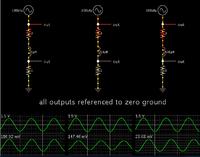KSHATRIYA
Member level 1
Hi All,
I wanted to use an oamp and measure the phase between voltage and current. I need to view this on an oscilloscope. I wanted to measure the phase shift between V & I circuit with an inductor load for a 100Khz sinusoidal signal input. At present I used a current sense method by putting a 1 ohm resistor at the output of a current buffer which drives the load and using a differential aplifier amplfying the differance at both the ends. I see that the output is almost in phase with the input voltage wheras it should have a phase lag. Is there anything that I am missing.
Sinusoidal Signal: 100khz Vp-p =3.3V
BUF634P for current driving.
AD620 used as differential apmlifier.
Thank you
Kshatriya
I wanted to use an oamp and measure the phase between voltage and current. I need to view this on an oscilloscope. I wanted to measure the phase shift between V & I circuit with an inductor load for a 100Khz sinusoidal signal input. At present I used a current sense method by putting a 1 ohm resistor at the output of a current buffer which drives the load and using a differential aplifier amplfying the differance at both the ends. I see that the output is almost in phase with the input voltage wheras it should have a phase lag. Is there anything that I am missing.
Sinusoidal Signal: 100khz Vp-p =3.3V
BUF634P for current driving.
AD620 used as differential apmlifier.
Thank you
Kshatriya
